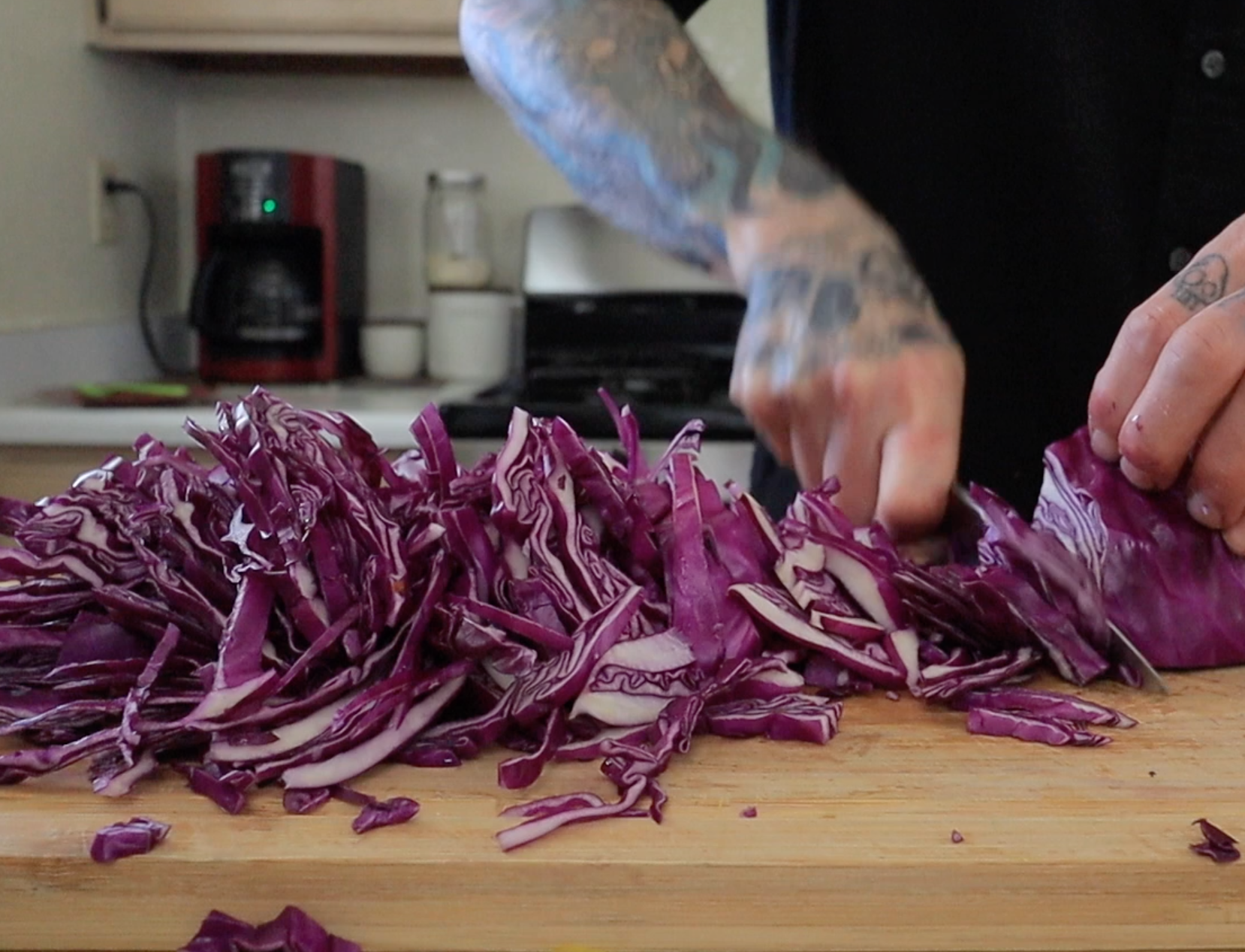Red Cabbage Sauerkraut: A Beginner’s Guide To Homemade Sauerkraut
Starting out in the world of lacto fermentation? Making sauerkraut is the perfect starting point for beginners as you only need to ingredients for it to work. Cabbage and salt! The rest is in the magic of the lactic acid bacteria, the good group of bacteria that makes lacto fermentation work. I go into more detail in my video. Click the button to learn more!
Ingredients:
1 medium red cabbage
Kosher salt (done by weight)
1 golden beet
1 tsp cardamom
Tools needed:
Sharp knife
Cutting board
Rolling pin with no handles
Large mixing bowl
Kitchen scale
Vegetable peeler
Ziptop bag or fermentation weight
Mason jar - 32 oz or larger
16 oz mason jars for storage after fermentation is complete
Mason jar lid
Parchment paper
How to make it:
Cut the ends off the beet and peel with vegetable peeler. Grate the beet on a box grater.
Wash and dry the cabbage. Remove the outer leaf and save for later.
Cut the cabbage in half and cut out the core and stem. Cut the cabbage halves in half again. I like to cut the cabbage thinly with a sharp knife. I found that I like the texture of the finished sauerkraut when it is sliced a little thicker than if you grated the cabbage on a box grater. If you like, you can grate your cabbage. The texture is personal preference and I prefer to have a little bit of a bite on the finished sauerkraut.
If you don’t have a scale, you can use roughly 1 tbsp kosher salt for a medium sized cabbage. A larger on may take about 1-1/4 to 1-1/2 half tbsp salt.
For accuracy and food safety, I prefer to weight out my ingredients and calculate the amount of salt needed. To figure that out, place the large mixing bowl on the scale, tare it and add the shredded cabbage and beet to the bowl. Record that weight and multiply it by 2%
In my example from the video I made, the shredded cabbage and beet weighed 928 grams. So, 928 x .002 = 18.56 g. This is the amount of salt needed. If your scale doesn’t read decimal points, round to the nearest whole number. The salt amount difference is minimal if rounded up or down.
Place a small dish on the scale, tare it and add the calculated amount of salt.


Add the salt and cardamom to the mixing bowl. Mix the salt together with the cabbage and allow to sit for about 5 minutes. This will help draw out moisture from the cabbage. Using your hands, massage the cabbage until it starts to break down and release its liquid.


Add the cabbage to a mason jar and push the cabbage down further with a rolling pin to release more of the moisture. The point of this is to get the liquid released from the cabbage to cover the cabbage. Place the leaf on to the top surface of the cabbage and place a ziptop bag filled with water on top of the leaf. It is important to keep the cabbage under the liquid (brine level). The fermentation process works with an anaerobic environment. The lactic acid bacteria responsible for fermenting and preserving the cabbage and needs to be in an environment that lacks oxygen. The salt’s purpose is to ward off any bad bacteria. Too little salt and it won’t be able to do so, too much and it will kill off the good bacteria. Hints the reason why I like to be more precise and weigh the cabbage as described above.
Allow to ferment on the counter or pantry away from direct sunlight. Make sure that if you put a lid on the jar that has no airlock, keep it loosely screwed on so gas doesn't build up and possibly cause the jar to burst. The best temperature range for fermentation is around 68-75 degrees F. The fermentation period is between 7 days to 3 weeks which can be adjusted according to personal taste. I like the texture of the sauerkraut when fermented for around a week to a week and a half. On day 3 or 4, you should notices signs of fermentation. This will look like tiny bubbles starting to form and collect on the surface of the cabbage. This is a by product of the lactic acid bacteria consuming the natural sugars in the cabbage and beet.
When the fermentation period is over, the sauerkraut should smell acidic, sweet and slightly sour. I like to check the pH of the brine to make sure the fermentation process took. I’m looking for a pH of 4.6 or lower to be safe to consume the sauerkraut. If the cabbage was kept under the brine level during the fermentation period, there is little to no chance of mold formation. If there is any mold that has grown, discard the batch and make another one after you figure out what may have happened. I take no chances when it comes to food safety.
I portion the sauerkraut out into smaller 16 oz jars and store in the refrigerator to slow the fermentation down. I recommend you place a piece of parchment paper between the jar opening and the jar lid to avoid the acidity of the sauerkraut from eating the metal on the lid.
This will stay good for months in the refrigerator, but I tend to go through it rather quickly.
Enjoy with this beer braised bratwurst! Of course, you don’t want to heat it up as the heat will kill off the beneficial bacteria. Also goes great as a side, on grilled cheese and burgers.
Logan



